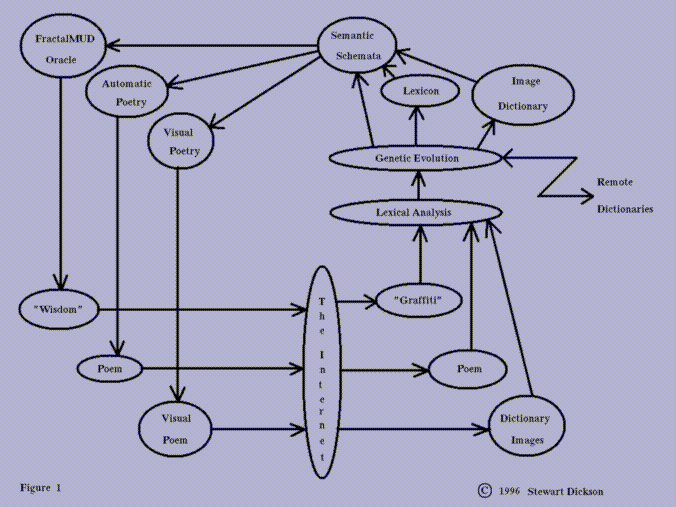
Mathematics is a universe of discourse transacted in symbolic language. It is really very general. Computer languages like Mathematica(R) implement nearly the entire set of natural mathematical language - a language which pre-dates computing machinery by several thousand years. Mathematica also includes LISP-like object-oriented programming constructs which allow for extension of the language, and hence the universe of discourse.
The Fractal MUD Oracle and Automatic Poetry originally employed random substitution into various semantic schemata. This produces results which I find amusing and it occasionally produces "gems of random wisdom". I built the dictionaries "by hand", which defined the scope of the universe the Oracle and poems could talk about.
I have now closed the conversational loop in my discursive system: The user can now input their own poetry, and the Graffiti received by the Oracle is now analyzed by the system and results in new semantic schemata in each area.
I have noticed that a stock photography catalogue is like a visual dictionary. The catalogue is categorized, with category headings denoted by image icons. But the image definitions are vague and the "dictionary" is imprecise.
Therefore, the MathArt dictionary also has image attachments to each database entry. These are visual icons for the words. Visual Poetry is a first attempt at composing images which have one-to-one equivalence to abstract statements and a means of applying symbolic computation to computer image composition. The goal is to generate a correlation between natural language and compact, two-dimensional symbols.
The following is a schematic diagram of how the system works:

The system is a regenerative philosophy engine driven by the HTTP forms in FractalMUD and Automatic Poetry. You may query the dictionary to see what the database entries look like. The lines of the dictionary entries are symbolic statements which are entered into the global rule base of the dictionary.
The system is meant to be as simple as possible, first to support the FractalMUD Oracle and Automatic Poetry, but it is meant to be easily extensible - an open system, so that complexity may be built on top of it.
Meaning in the Dictionary is is constructed topologically - synonym and antonym entries become linkages to other words - other entries in the dictionary. The dictionary becomes a "web" of meaning. Thus, the cohesion of the dictionary is imposed by its structure, not its size. The dictionary should be fully functional at any size, and therefore scalable.
The dictionary is currently being built primarily in English, the author's primary, native language, but it is designed to support multiple languages. The key to building the dictionary is to give the user a means of communicating - through the input of poems and Graffiti. The Dictionary then interprets this input. Unknown words are trapped and a fill-out form is returned to the user who supplies the definition for the words.
The fill-out forms are not yet fool-proof. Incorrect entries can be made which tend to degrade the performance of Automatic Poetry and the FractalMUD Oracle. To combat this, I have developed some administrative tools which periodically scan the database for certain inconsistencies.
When users enter poetry, the most common incompleteness introduced in the dictionary are verb conjugations. Since every verb generally has thirty-six modified forms, entering a new verb in the dictionary - by word uniqueness - only enters one form for that verb, leaving thirty-five forms of that verb incomplete. Attempts by a semantic schema to generate a given modified form - tense, plurality, person - for a verb which is missing the entry for that form returns a (null) result in the output.
There is therefore a maintenance tool which scans the semantic schemata for verb modification forms, then scans the dictionary for the modified forms defined in the schemata. Verb conjugation fill-out forms are then generated for verbs missing the modified forms called-for in the schemata.
Another frequent deficiency in the Dictionary are image URLs which serve as visual icons or visual definitions of the words.
Censorship
To my knowledge, the MathArt Dictionary contains no words which do not appear
in any Webster's dictionary. This is my intent. I even permit poetic
license to construct new words for special tasks of meaning. The only
requisite criterion is that the word be adequately defined.
Words pertaining to parts of the human body I view as anatomical studies, and I believe they are appropriate to include as such. The image fragments I select to describe these words I choose carefully to read correctly in as wide a range of contexts as possible. I encourage the same kind of selectivity and discretion in contributions from the Internet community.
I am against censorship in principle. I believe that the images I have selected are in good taste. I avoid images of violence where possible.
If the results of the random schemata appear crude, it is because of the state of evolution of the system. As it grows, it should reach something approximating the general state of discourse on the Internet. The content of the dictionary should match the attitudes of the audience who created it.
In order to adequately deal with legislation such as the recent Communications Decency Act of the United States Congress, there are defined "censorship" memes - or symbolic definitions attached to words corresponding to the Motion Picture Association of America (MPAA) rating codes. These symbols are used to voluntarily filter on the receiver's side, the transmission of image icons or words by content.
Ultimately, the way the system operates, the memes should evolve toward a general consensus regarding the acceptability and appropriateness of the words and images being used.